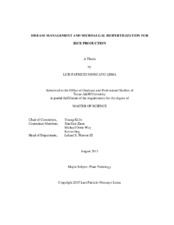| dc.description.abstract | Sheath blight (ShB) caused by Rhizoctonia solani AG1-IA, narrow brown leaf spot (NBLS) caused by Cercospora janseana and fertility are among the most important factors limiting rice production in the U.S. Greenhouse experiments were conducted to better understand the effects of temperature and cultivar resistance on the biocontrol efficacy of Bacillus subtilis strain MBI 600 for management of ShB. Also, lab and field trials were conducted to evaluate the efficacy of fungicides for control of C. janseana and NBLS. In addition, greenhouse and field trials were conducted to explore the use of microalgae-based biofertilizers for rice production. In the first study in the greenhouse, plants of two rice cultivars (moderately resistant and susceptible to ShB) were spray treated with strain MBI 600 and subjected to different temperatures for 24 hours in dew growth chambers. Disease severity was assessed after 8 days of incubation. In the second study under in vitro conditions, fungicide sensitivity of C. janseana based on the percentage relative germination and the effective concentration that inhibited 50% of conidia germination were assessed. A field trial was also conducted in 2012 and 2014 to evaluate the efficacy of fungicides for control of NBLS and yield improvement. In the third study, greenhouse and field trials were conducted to evaluate the effects of N2-fixing cyanobacterial biofertilizer, microalgal biomass concentrate, and urea fertilizer on rice plant height and yield.
In the first study, temperature significantly affected the relative biocontrol efficacy of strain MBI 600 in reducing ShB development in either cultivar. Its efficacy linearly increased with the increase of temperature, reaching the maximum at 35 or 40°C.
In the second study, the succinate dehydrogenase inhibitor fungicides fluxapyroxad and flutolanil were most and least effective, respectively, in inhibiting C. janseana conidia, indicating that there was no cross-resistance between fluxapyroxad and flutolanil. Fluxapyroxad, propiconazole alone and in combination with azoxystrobin or trifloxystrobin were highly effective controlling NBLS. However, azoxystrobin was not effective to control NBLS.
In the third study in the greenhouse, microalgal biomass concentrate treatment significantly improved rice plant height. However, no biofertilizer treatments improved rice yield in the field. | en |


